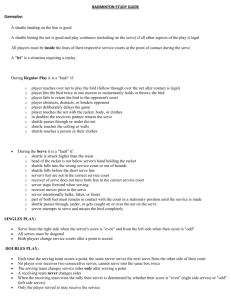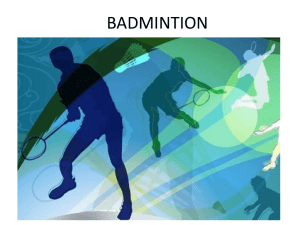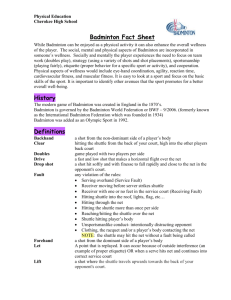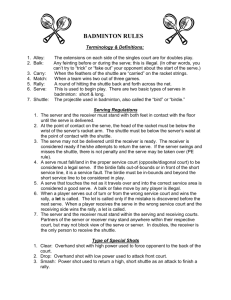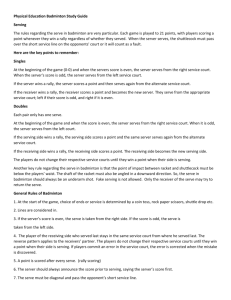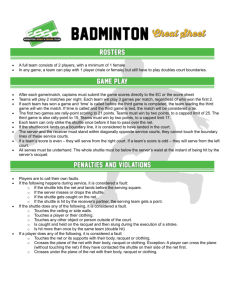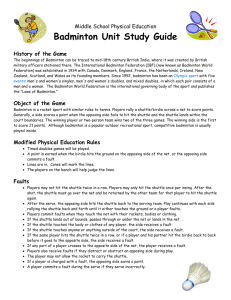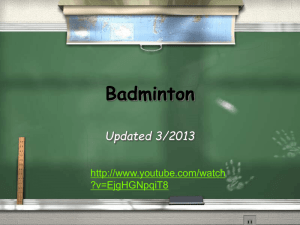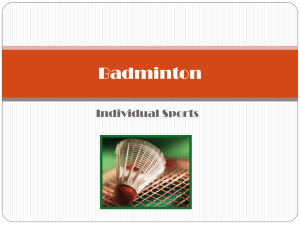badminton
advertisement
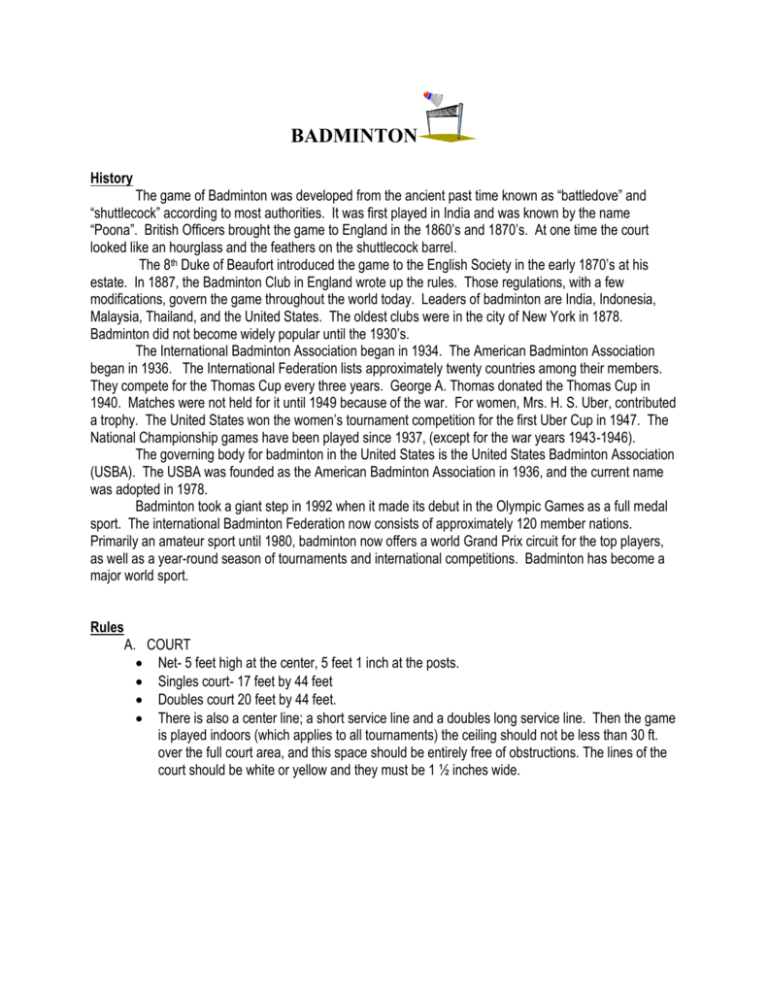
BADMINTON History The game of Badminton was developed from the ancient past time known as “battledove” and “shuttlecock” according to most authorities. It was first played in India and was known by the name “Poona”. British Officers brought the game to England in the 1860’s and 1870’s. At one time the court looked like an hourglass and the feathers on the shuttlecock barrel. The 8th Duke of Beaufort introduced the game to the English Society in the early 1870’s at his estate. In 1887, the Badminton Club in England wrote up the rules. Those regulations, with a few modifications, govern the game throughout the world today. Leaders of badminton are India, Indonesia, Malaysia, Thailand, and the United States. The oldest clubs were in the city of New York in 1878. Badminton did not become widely popular until the 1930’s. The International Badminton Association began in 1934. The American Badminton Association began in 1936. The International Federation lists approximately twenty countries among their members. They compete for the Thomas Cup every three years. George A. Thomas donated the Thomas Cup in 1940. Matches were not held for it until 1949 because of the war. For women, Mrs. H. S. Uber, contributed a trophy. The United States won the women’s tournament competition for the first Uber Cup in 1947. The National Championship games have been played since 1937, (except for the war years 1943-1946). The governing body for badminton in the United States is the United States Badminton Association (USBA). The USBA was founded as the American Badminton Association in 1936, and the current name was adopted in 1978. Badminton took a giant step in 1992 when it made its debut in the Olympic Games as a full medal sport. The international Badminton Federation now consists of approximately 120 member nations. Primarily an amateur sport until 1980, badminton now offers a world Grand Prix circuit for the top players, as well as a year-round season of tournaments and international competitions. Badminton has become a major world sport. Rules A. COURT Net- 5 feet high at the center, 5 feet 1 inch at the posts. Singles court- 17 feet by 44 feet Doubles court 20 feet by 44 feet. There is also a center line; a short service line and a doubles long service line. Then the game is played indoors (which applies to all tournaments) the ceiling should not be less than 30 ft. over the full court area, and this space should be entirely free of obstructions. The lines of the court should be white or yellow and they must be 1 ½ inches wide. B. RACKETS Rackets can be made of wood, steel, fiberglass, carbon, graphite, boron or aluminum. They are very light- around 3.5 ounces. The racket’s overall dimensions cannot exceed 27 inches by 9 inches, and the length of the head cannot exceed 13 inches. Rackets are strung with gut or some sort of synthetic string, like nylon. A racket should be strung at between 15 and 20 lbs. of tension. Rackets come with a handle grip made of leather or polyurethane. C. SHUTTLE Shuttles used to be feathered with rooster feathers and be called shuttlecocks. Now, shuttles are made from plastic or rubber material and are just called shuttles o The slang term for a shuttle is a birdie. The feathered shuttle must weigh from 4.74 to 5.50 grams and have 14 to 16 feathers fixed in a cork base covered with a thin layer of leather or similar material. The heavier the shuttle, the faster it flies. D. PLAYERS Players are those persons taking part in the game; one player on a side in singles, two players on a side in doubles. The side, which has the serve, is called the “in” side and the opposing side, the “out” side. E. SERVING AND SCORING An underhand serve starts play. o Must be below the waist. If the serving side scores a point, it keeps the service and starts the next rally with a new service from the left or right service court, depending on whether its score is odd or even. If the returning side scores a point, it also wins the right to serve. Each time an exchange or rally is won, one point is recorded. Doubles play to 21 points, you must win by two. 21-22 cannot be a winning score; it would need to be 21-23. The returning team needs to ready; the serving team may serve whenever they want. The do not need to wait for you to be set. An inning is a term of service. Faults Serving: 1. Striking the shuttle higher than the waist at contact. The serve must be underhand and the entire shuttle must be below the server’s waist on contact. 2. Head of the racket above hand at contact. 3. Shuttle landing in the wrong service court, short or out of bounds. 4. Feet of server and receiver not in service court until service delivered. 5. Both feet of server not in contact with the ground at contact of the serve. 6. If a player attempting a serve misses the shuttle completely. 7. A serve hitting the top of the net and going into the correct service court is LEGAL and IN PLAY. Other Faults 1. 2. 3. 4. 5. 6. 7. 8. 9. Shuttle struck before crossing the net. Player touches the net when shuttle is in play. Shuttle is thrown from the racket. Player is hit by the shuttle. Player may not touch the net or the net posts with one’s body, racket, or clothing. If the net is hit following a stroke and after the shot has struck the floor, a fault doesn’t result because the shuttle is not “in play” after it strikes the floor. Shuttle may not be hit twice in succession. Player may not reach over the net to contact a shuttle. A player may not step on the opponent’s side of the net. If the shuttle goes over the net, but catches on the other side, a let results. The point is replayed. SERVING ROTATION Example: A and B play against C and D. A and C start the set on their respective right service courts, B and D on the left service courts. At 0-0, A plays the first service from the right service court. C is the returning player. If A and B win the rally, they score a pint and lead 1-0. A then moves to the left service court (and B, by implication, to the right one). C and D remain where they are. At 1-0, A serves again, this time from the left. C and D win the rally and score a point. However, as they did not serve in this rally, they do not change service courts. At a score of 1-1, their score is odd and therefore D, being the player on the left service court, wins the right to serve. D then serves to A and C and D wins another point. D and C therefore change service courts and D continues to serve, this time from the right hand side, at a score of 2-1. If A and B win the next rally, they equalize and win back the right to serve without changing service courts. A is now on the left service court and the side’s score is even (2-2), therefore B wins the right to serve (from the right service court) Even scores are served from the right side of the court and odd scores are served from the left side of the court. SIDE BY SIDE DEFENSIVE FORMATION A team in a side’s formation divides the court down the middle from net to back boundary line. Each player covers half of the court, both front and back. The down the middle shots, those directed between the two players, are usually played by the player on the left side since the center is that player’s forehand side. The advantage of the sides system is that the area, which each player is to defend, is well defined and there is little confusion about who is to cover which, shots. The disadvantage of the system is that the opposite team can play all the shots to one side, up and back, and tire one player. If one player is weaker than the other is, the opponents will naturally launch their attack on that player. UP AND BACK FORMATION In this system the court is divided in such a way that one player plays the forecourt and the other the backcourt. The advantage of the up and back system lies in the fact that there is always a player at the net to “put away” any loose returns. This keeps the pressure on the opponents. The disadvantage of the up and back system is that the mid-court area and along the sidelines is vulnerable. The half-court shot that is played just behind the net player and just in front of the backcourt player tends to cause confusion as to which player is to hit the shuttle. Low Serve- Shuttle goes over the top of the net with minimum clearance. Swing is shortened; keep an extremely firm wrist. Stroke is made almost entirely with forearm. This should cause your opponent to hit the shuttle UP. Clears- Used to gain time to recover the center position and to force your opponents to the backcourt. Underhand- Played from the area by the baseline to the opponent’s side of the net as near to the net as possible. In doubles, the drop shot is used to run the net player from side to side or to draw a player up when both players are back. Smash- Overhead shot use to “put away” any shuttle above the height of the net. Grip the handle firmly at contact. Contact shuttle at the highest point. The follow through is down and in line with the flight of the shuttle. Racket face must be angled downward at contact point. The farther away you are from the net, the less angle and speed the smash can carry. TERMS Alley- The areas on each side of the court which enlarge the court for doubles play, 1 ½ feet wide and run the length of the court. Backhand- Refers to the strokes played on the non racket side of the body, i.e. with the racket across the body. Balk- An attempt to throw the opponent off balance by feinting or using false starts before or during a service attempt. Baseline- Back boundary line at each end of the court, parallel to the net. Birdie- officially known as the shuttlecock. Carry- Illegal tactic; also called sling or throw, in which the shuttle is caught and held on the racket and then slung during the execution of a stroke. Center line- Line perpendicular to the net that separates the left and right service courts. Clear- A shot hit deep to the opponent’s back boundary line. Cross court- Shot hit diagonally from one side of the court to the other. Double hit- an illegal tactic in which the shuttle is hit twice in succession with two strokes. Doubles- Game played with two players on each side. Drop- A shot hit softly and with finesse to fall rapidly and close to the net on the opponent’s side. Face- The oval, stringed area of the racket head. Fault- A Violation of the playing rules. Flight- The path or trajectory of the shuttle. Forehand- Refers to the strikes played on the racket side of the body. Game- Unit of points necessary for victory; game consists of 21 points. Must be ahead by 2 points to win. Grip- The hold on the racket. “In” Side- the player or side that is serving. “Out” side- The player or side that is receiving the serve. Inning- Time during which a player or team holds the service. Love- No Score. Match- A series of games, usually 2 out of 3, to determine a winner. Net- 2 ½ foot wide, 5 foot 1 inch from the top of the net to the floor at the ends, 5 foot in the middle. Out- Shuttle lands outside the boundary lines. Overhead- Refers to stroke played above head level. Point- Method of scoring, only the server can score a point. Racket- Implement used to hit the shuttle. Shaft- part of racket between the head and the handle. Smash- A hard hit overhead shot that force the shuttle sharply downward. It is badminton’s chief attacking stroke. Throat- Part of the racket where the shaft joins the head. USBA- United States Badminton Association; governing body for badminton. Underhand- refers to a stroke that contacts the shuttle below the waist, such as a serve or a clear from the net.
